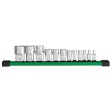
When working in construction, you may find that you need lots of differently-sized vehicles. Some trucks will be better suited for your work than others which is why it is important to know the difference between light-duty and medium-duty vehicles.
Depending on the gross vehicle weight rating (GVWR), vehicles will be categorized as anywhere between Class 1 - Light-duty to Class 8 - Heavy-duty. Each duty line has multiple classes of vehicles within it - each having an array of trucks and vans making it up. You can learn about what each class entails and how the varying weights and payloads can benefit your line of work.
Truck Classifications
The lighter the vehicle class, the more likely that it is used for non-commercial use.
Classes 1-3 are considered to be the light-duty vehicle categories. Medium-duty trucks are Classes 4-6 and are used for bigger companies and commercial use.
Class 1
Class 1 vehicles include all trucks and vans with a GVWR ranging from zero to 6,000 lbs. These are the lightest of the light-duty vehicles. Uses for this class of trucks and vans include things like repair businesses.
Some examples of Class 1 trucks and vans are:
- Toyota Tacoma
- Ford F-150
- Mullen ONE
Class 2
Class 2 vehicles include trucks and vans with a GVWR between 6,001 lbs and 10,000 lbs. These kinds of trucks are often described as fullsize pickups. Vans in this category are typically step vans or cargo vans. This class is commonly used by small contractors or individuals for things like construction, landscaping, and even emergency services.
Some examples of Class 2 trucks and vans include:
- Ram 2500
- Ford F-250
- Ford Transit 250
Class 3
Class 3 vans and trucks have a GVWR between 10,001 lbs. and 14,000 lbs. These are the heavy-duty pickup trucks and box trucks. This class usually has vehicles used in commercial settings and can include anything from city buses to smaller delivery trucks.
A few examples include:
- Ram 3500
- Ford F-350
- Ford Transit 350
Class 4
Class 4 vehicles include trucks and vans with a GVWR ranging from 14,001 lbs. to 16,000 lbs. At Class 4, the vehicles start being categorized as medium-duty. This class typically uses vehicles for transporting things, delivery services, and landscaping.
Some examples of this class of truck are:
- Ram 4500
- Ford F-450
- Mitsubishi Fuso FE 160
Class 5
Class 5 trucks and vans with a GVWR of 16,001 lbs. to 19,500 lbs. These vehicles are highly used in towing, waste management, emergency response, construction, etc. They are the larger size delivery trucks and smaller size dump trucks.
Examples of this class vehicle are:
- GMS Sierra 5500HD
- Ford F-550
- Chevrolet Silverado 5500HD
Class 6
Class 6 vehicles have a GVWR between 19,501 lbs. and 26,000 lbs. These can be seen as single-axel trucks, local delivery trucks, etc. They are often used for transportation of various needs.
Some examples include:
- Peterbilt 220
- Ford F-650
- Ram 6500
Class 7
Class 7 vehicles include trucks with a GVWR of 26,001 lbs. to 33,000 lbs. These kinds of vehicles cover things like city buses, utility services, waste management, or cement mixers. This class is the start of the heavy-duty vehicles.
A few truck examples are:
- Mack Granite
- Ford F-750
- Chevrolet Silverado 7500HD
Class 8
Class 8 vehicles include all trucks and vans with a GVWR surpassing 33,000 lbs. These trucks and vans are the biggest and heaviest of the commercial vehicles. They are powerful machines used for things such as dump trucks and heavy haulers. They are found in industries like mining, freight hauling, long-haul trucking, etc.
Examples of this class include:
- Peterbilt 389
- Kenworth T680
- Freightliner Cascadia
What GVWR Means on the Jobsite
The GVWR of vehicles also indicates how big their payload can be. This is what will affect how much can be transported or loaded onto the vehicle. Being light-duty vehicles, Class 1 and Class 2 typically have 1,000 lb. payloads. Class 2 and Class 3 are capable of having 1,500 lb. payloads and the payload capacity just goes up from there.
On the jobsite, each business and contractor will need power and payload capabilities unique to their work and current job. The industry that the vehicle will be needed in may also play into deciding on a light- or medium-duty truck.
Many companies will choose to have a variety of truck types and different payload capacities. It all comes down to what is needed for the type of work and each specific job site.
Who Uses Each Class
The classes often correlate with the business and the size of the company.
When it comes to small businesses, the light-duty weight class is typically seen for individuals and small businesses. This trend continues as the classes and power go up in the vehicles. Larger businesses will go for stronger vehicles. Medium-duty trucks and vans are often preferred for more durability and power.
When deciding what your company might need, it is important to do your research and see exactly what you are looking for and what would best suit you and your fleet.
















